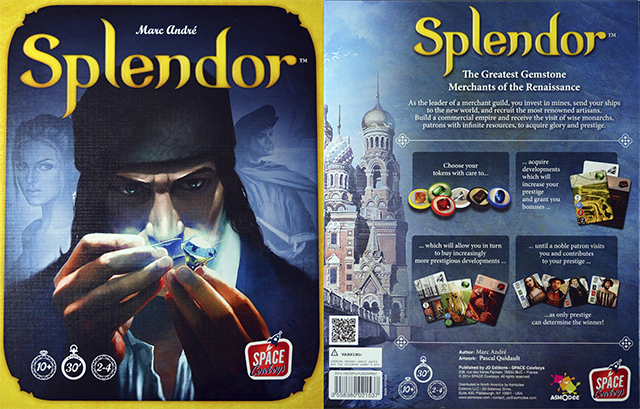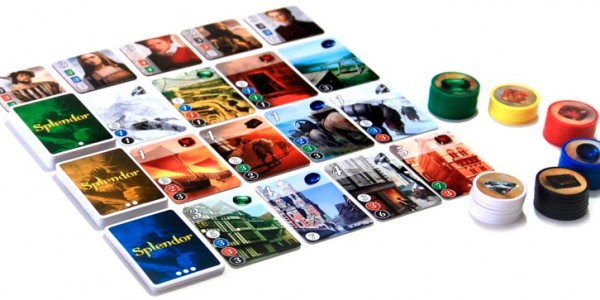 It’s the Renaissance and you are a gem merchant, acquiring, trading, and selling gems…or something.
It’s the Renaissance and you are a gem merchant, acquiring, trading, and selling gems…or something.
Splendor‘s theme is entirely pasted on, but the game’s mechanics are well worth the price of admission. Splendor‘s simple and elegant yet deep and engaging engine-building design scales well with two to four players, and provides a varying blend of strategic and tactical competition between players, who will find themselves sometimes minding their own business, while at other times fiercely and deliberately foiling one another’s plans. Splendor was a Spiel des Jahres nominee, and it’s easy to see why.
The game revolves around card drafting and set collection. The fantastically weighty and tactilely satisfying gem tokens at the heart of the game are collected in order to purchase cards from a tableau laid before the players in three tiers. Each tier is more expensive than the last, but the level one cards mostly earn players no points, while level two cards earn one to three points and level three cards are worth three to five points each. The gem tokens are a consumable resource, and return to the supply with each purchase, but each of the aforementioned Development cards grants a single permanent gem of one of the game’s five types (diamond, sapphire, emerald, ruby, and onyx, or as most will end up calling them, white, blue, green, red, and black).
The rules are simple and can be learned in a matter of minutes. On a player’s turn he or she may do one of the following:
- Take two gems of the same color (if there are at least four gems of that type in the supply).
- Take three gems, each of a different color. There is a “hand limit” of 10 gems per player, total.
- Reserve a card from the face-up tableau or from one of the three face-down Development decks, and take one wild (gold) token. You may only have three cards reserved at any given time.
- Purchase a card for the number of gems listed on its lower left-hand corner (using a combination of tokens and your permanent supply from previously purchased cards), either from the face-up tableau or from your reserved cards. Cards purchased from the center supply are replaced at the end of each player’s turn.
And that’s all. One of the most wonderful aspects of Splendor is its simplicity. It takes about a minute to set up and only a couple of minutes to put away, but provides a very deep and engaging experience for the duration of its 30-minute play time. That ability to pick up and play the game quickly is wonderful, though sometimes games can feel a bit short due to the 15-point win condition. This is actually not a bad problem for a game to have because it means that A) everyone is having fun and wants to play more, and B) you can simply increase the number of points required to win in order to extend the game, or of course just play again.

The game offers tremendous replay value as a result of its somewhat abstract nature. In every game, players are dropped in with equal opportunity to use the available resources to build a strategy and attack the task at hand in their own way. Still, things don’t always work out, especially as the player count increases and the game shifts from more strategic to more tactical, forcing players to react to how the cards have changed each time their turn comes around. A contingency plan, or two or three of them, is imperative, and players will undoubtedly find Splendor to be an excellent mental exercise.
The lay of the cards will be different at every stage of every game of Splendor, and despite the ratios of gem requirements being equal across Development cards, each game also has a variable in the form of 10 Noble tiles. These are tiles placed above the Development card tableau that list specific requirements to earn what are essentially bonus points. Once a player has a certain number of permanent gems in his personal stock, he takes the Noble tile for which the requirements have been met. There will only ever be a maximum of five of these Noble tiles (in a four-player game), so the combination of tiles will always be different and will always have a differing influence on the relative value of each type of gem.
It’s surprising just how much depth and how many hours of enjoyment can be packed into a few stacks of cards and poker chips (which happen to come packed in a larger-than-necessary, but entirely awesome box). Space Cowboys and publisher Asmodée have a real, uh, “gem” of a game in Splendor. Elegant is truly an apt description for this simple game that is far greater than the sum of its parts.


















